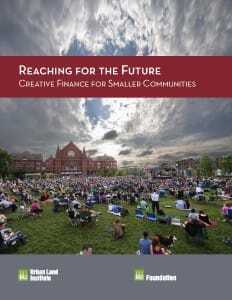American cities seeking to reinvent themselves can do so by using creative financing, among other tools, according to a panel of experts at the 2016 ULI Spring Meeting in Philadelphia. The panel also served as the launch event for the new ULI publication Reaching for the Future: Creative Finance for Smaller Communities.
Municipalities must first take inventory of their competitive advantages, sincerely want to transform, be willing to take on some risk, and use innovative public/private partnerships, said Thomas Murphy, ULI senior resident fellow and a former mayor of Pittsburgh. “There is always money somewhere; it’s the vision of where you want to go that’s important,” said Murphy. “The conversation must begin with the community making a choice of what it wants to be.”
Metropolitan areas across the United States—including Greenville, South Carolina; Bethlehem, Pennsylvania; and Cincinnati, Ohio—have taken control of their destiny and successfully transformed themselves. “Today, many cities are trying to figure out their place in the world,” said Murphy. “Virtually every city has seen a decline in manufacturing. A city making a new choice about its future needs a clear understanding of what its competitive advantages are. In addition, cities should have strong leadership, a strategic vision, and knowledge of public financing tools.”
Municipalities must also become entrepreneurial. “There is always money available. You just have to know where to look,” Murphy said. “The ideas are more important and the vision of where you want to go.”
An example is Greenville, a textile market that decided to reinvent itself decades ago. “One of its advantages was that Greenville was the site of the largest textile convention in world, and European companies visited Greenville,” said Stephen P. Navarro, executive vice president in the Greenville office of CBRE. “European firms knew about its ‘Southern’ advantages: it is a right-to-work state, has a low cost of living, cheap taxes, and low-cost labor.”
Before long, overseas companies started expanding into the area. International tire maker Michelin established its U.S. headquarters in Greenville, and later BMW opened a plant there that now manufactures more cars than any other site outside Germany.
Developers began to revitalize Greenville’s central business district, focusing on the Reedy River Falls, which had been hidden by a massive, ugly bridge.
“Many people didn’t know about the waterfalls. Greenville didn’t have any tourism to speak of, job generators, nor significant history,” Navarro said. “What it did have was strong leadership. Greenville had three amazing mayors over 30 years, all with a similar attitude to think big. All were great communicators to the public sector, to their staff, and to the business community.
“In addition, Greenville had a strong city administration with an ability to create partnerships and to plan and invest in infrastructure that laid the groundwork for development. This is probably the most important element of Greenville’s success,” he said.
Strong civic leadership was important in the transformation of downtown Cincinnati, said Anastasia Mileham, vice president, marketing and communications, at Cincinnati Center City Development Corporation (3CDC), a private nonprofit real estate group.
“We had a visionary mayor that kick-started it, and companies such as Proctor & Gamble, Macy’s, Western & Southern, Kroger, GE, and others contributed funds. They looked at the city two decades ago and said, ‘We have to do something about economic development to recruit the best and the brightest to live and work in the city.’ They put money where their mouth was and pooled $50 million to create 3CDC.”
Targeted for revitalization by 3CDC was Cincinnati’s Over-the-Rhine neighborhood, which then was known for having one of the highest crime rates in the city. Today, the area—believed to be the largest, most intact urban historic district in the United States—has undergone a transformation to become one of Cincinnati’s most vibrant neighborhoods.
Also refurbished by 3CDC was the city’s Fountain Square, and the organization continues to revitalize Cincinnati’s central business district. “Fountain Square is a two-acre [0.8 ha] public space, but ten years ago [it] was blocked off from any pedestrian activity,” Mileham said. “It was a desolate space. Nothing happened except for people begging.”
Transformed by 3CDC, Fountain Square now is a mecca for visitors and offers about 500 free events a year that bring millions of visitors downtown.
Not that many years ago, Bethlehem, Pennsylvania, was also a municipality on a downward spiral, recalled John Callahan, former mayor of the city and now director of business development at Florio Perrucci Steinhardt & Fader. “At the end of the day, we really didn’t have a choice. We had to act,” he said. “Bethlehem Steel was closing and 20 percent of the population worked there. We couldn’t continue to see the city’s decline.”
Rather than try to be something it was not, the city decided to build on its past. “What makes Bethlehem special is Bethlehem Steel,” he said. “So we decided to build on that uniqueness of 125 years of steelmaking history.”
Jump-starting the city’s economic recovery was the Sands Casino Resort Bethlehem, which opened in 2009 on the old Bethlehem Steel grounds. Today, tens of thousands visit the tables every day. “Redevelopment was funded almost exclusively with tax increment financing revenues from the casino complex,” Callahan said.
Greenville, Bethlehem, and Cincinnati are three remarkable communities that made a clear choice, said Murphy. “They wanted to be something that they weren’t, and they all did it their way,” he continued. “In Greenville and Bethlehem, change resulted from public officials. In Cincinnati, the transformation was driven by the private sector. 3CDC is a model that has importance to every city. Every city has some major companies and wealth.”




![Western Plaza Improvements [1].jpg](https://cdn-ul.uli.org/dims4/default/15205ec/2147483647/strip/true/crop/1919x1078+0+0/resize/500x281!/quality/90/?url=https%3A%2F%2Fk2-prod-uli.s3.us-east-1.amazonaws.com%2Fbrightspot%2Fb4%2Ffa%2F5da7da1e442091ea01b5d8724354%2Fwestern-plaza-improvements-1.jpg)

